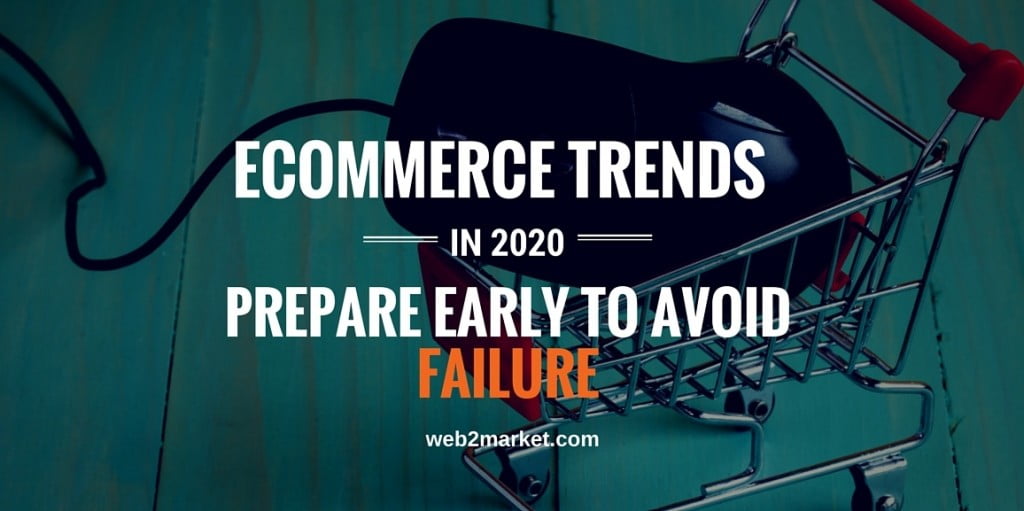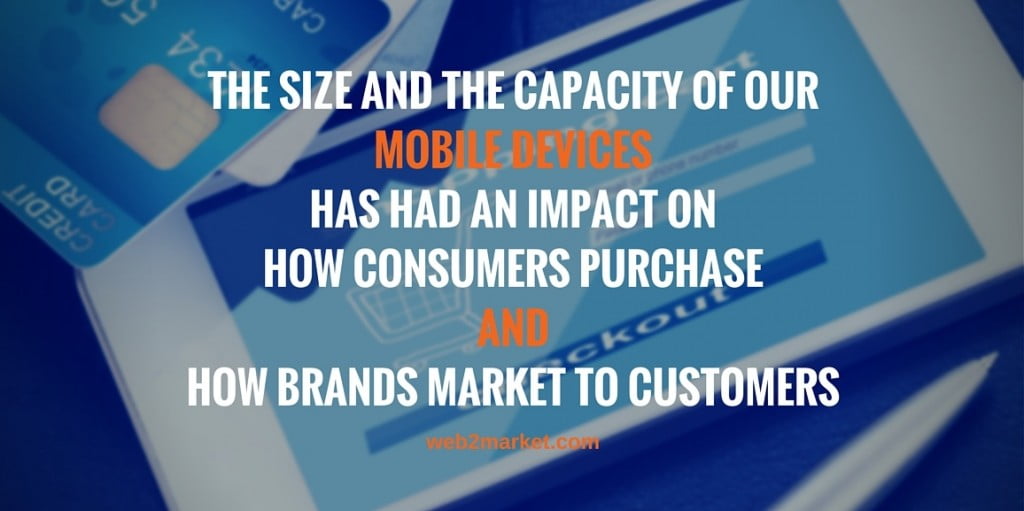- Increased desire to leverage customer context, driving the need for robust content management.
- Customers will continue to seek the convenience of multichannel. Savvy eBusiness leaders will look to their eCommerce technology providers to minimize the complexity of serving customers via many touchpoints.
- Business-to-business (B2B) eCommerce will emerge as a growing and critical component of the overall sales landscape.
Pretty good predictions considering that in 2016 content is still a hot topic, multichannel has been renamed omnichannel and B2B eCommerce sales exceed that of B2C sales in the U.S.
At Web2Market, we like to talk about eCommerce trends. Nothing makes us happier than thinking about what we feel will be the up-and-coming eCommerce trends.. What an exciting time! With the emergence of Big Data, we are able to get a better understanding of our customers. That allows us to better comprehend their buying behaviors. The size and the capacity of our mobile devices has had an impact on how consumers purchase and how brands market to customers. Big Data and mobile phones have also paved the way for digital media and how we reach our customer through content marketing. Many trends are driven by consumers, some more than others. The customer’s need for a flawless customer experience and seamless journey with a brand, regardless of channel or device, will continue to put pressure on businesses to provide a better customer service.
In our report “Current Trends in E-Commerce, Is Your E-Commerce Site Competitive?” we assembled five eCommerce trends to watch in 2017. Unfortunately only five trends made the list while some got left on the cutting room floor. These trends didn’t make the cut because we felt that consumers weren’t quite ready for them in 2017, but we are confident that these trends will be well under way by 2020. Trends that you can prepare for now, to avoid failure in the future. So, without further ado, here are the five eCommerce trends that you can expect for 2020.

Five eCommerce Trends in 2020
1. Globalization and Localization
Globalization is the process of designing and developing applications that function for multiple cultures. Localization is the process of customizing your application for a given culture and locale. First let’s start with globalization.
As we approach 2020, globalization will become more prominent as companies will expand globally. Today, new market entry is easier than ever, paving the way for companies to expand into new markets in new countries. The borders that once existed have been eliminated due to ease of international shipping and consumer confidence of online purchasing. There is no longer the need to establish a company in a country in order to do business there.
As a result of globalization, eCommerce retailers will become more confident selling globally. Hence, we will even see them embrace key shopping dates in international markets. This is already starting with Black Friday. In the UK for instance, £810m was spent online by British shoppers on Black Friday in 2014. Surprisingly, Black Friday and Cyber Monday are no longer the largest online shopping days. Singles’ Day in China on November 11th, 2014 became the largest online shopping day in the world. Alibaba’s sales reaching US$9.3 billion in 2014 in one day. It’s safe to say that by 2020, more companies will be taking advantage of international holidays.
Localization
Localization will also become more common thanks to Big Data. Big Data makes it possible for businesses to identify global visitor traffic and buyer preferences on a global scale. That makes it easier to compete in international markets. This data is used to help businesses assess which markets are potentially the most lucrative for them to compete in. They can easily identify the buyer behavior of these new markets. Businesses will be able to tailor their offerings to appeal specifically to each market. That includes local sites that use the local language, currency and content specific to the customer. ECommerce reduces the barriers to entry and associated costs, allowing more businesses to compete globally.
2. Beacons and the Merge of the Online and Offline Worlds
Beacons are low-energy Bluetooth connections that allow companies to communicate wirelessly with mobile devices. Companies will use beacons to collect or send information to devices. Beacons provide companies with yet another avenue to use to engage with the customer. It’ll pick up a customer’s device signal, allowing the company to engage with them while in range. It is used to track movements and send targeted information based on these movements.
A beacon will help integrate the offline and online worlds by directing people who shop in-store to the eCommerce site. For instance, if you shop in a store and hover around the small appliance section, the beacon will recognize this and send you information. It can lead you to the store’s eCommerce site and possibly include an incentive for small appliances. Beacons will complement the omnichannel experience. This enables a seamless shopping experience, regardless of location.
3. Showrooming
Beacons and the Omnichannel experience lead us to another trend that, by 2020, could lead to entirely new experience for retail shoppers. Electric sheet tags and the evolution to showrooming will merge the online experience with retail stores. We will see more retail stores replace the standard cardboard price tags with electric sheets tags. These electric sheet tags work with smartphone apps – the smartphone apps will trigger a price display to flash as a customer approaches a product. The benefit for the retail store is that they can update pricing on the fly, in coordination with their website, reducing pricing errors to customers. The benefit to consumers is that they will receive promotional pricing that responds to their customer traffic patterns. A win-win.
Showrooming, or the practice of visiting a store in order to examine a product before buying it online at a lower price will become the norm, but will our brick and mortar’s become nothing but display cases for consumers to browse before completing their purchases online? Quite possibly. But reverse showrooming is becoming more common than showrooming according to a report by Harris Poll that discovered in the U.S. 69% of people reverse showroom, while 46% showroom. Reverse showrooming is when consumers go online to research products, and then go to the bricks-and-mortar store to complete their purchase. Whether we browse online and pick up instore, or browse instore and order online, beacon technology will provide a more omnichannel experience for the customer which will contribute to an increase in showrooming and reverse showrooming by 2020.
4. Seamless Online Payment for the Customer
Believe it or not, there is still a small percentage of us who won’t purchase online. 80% of the online population has purchased something using the internet, and 50% of the online population have purchased more than once. In addition, 18.5% of eCommerce orders are from a mobile device. Security, confidentiality and product quality being top reasons why some people don’t purchase online.
Payment options will become even easier for the customer and mobile payment will become the norm with the evolution of products like Apply Pay, Google Wallet and Android Pay. As technology evolves to keep up with this trend so will security measures and consumer confidence. Not only will payment be made via smartphone, but I’m sure we’ll also see payments possible via tablet, watch, iPad or other wearable technology – or whatever else comes down the pipeline in the near future.

5. What Won’t We Do For the Customer?
For our final ecommerce trends… The term “customer service” has evolved to become the “customer experience”. Instead of servicing the customer, it will be all about the experience for the customer. Online competition is fierce, so eCommerce sites need to do whatever possible to compete for the customer’s dollar.
Twenty-four-seven customer service is the norm in 2017, but by 2020 we will see shipping match the seven days a week standard. Even smaller merchants provide same-day delivery service that we have seen happen with large companies such as Amazon. Drones have been a hot topic in 2015 and Amazon has already started testing the use of drones for same-day delivery. Whether or not this comes to fruition in 2020, well, only time can tell, but we doubt it.
In Conclusion
The bottom line is that customer service isn’t a nice-to-have, the customer experience is a must-have, if you want to compete. The trend for the ultimate customer experience is being driven by the customer to the point that businesses have a hard time keeping up. The customer expectation is so high – demanding a well performing site, with good design, a seamless check-out experience and fast shipping. The fact is, if you fail to deliver this experience to your customer, they will go somewhere else. That’s why keeping up on trends and preparing for them now will help you avoid failure in the future. If you would like more information on eCommerce trends, contact us today.

